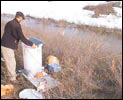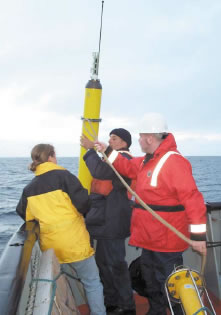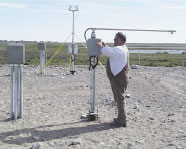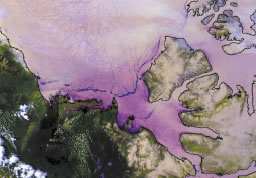|
Introduction |
Climate Change Action FundScienceClimate MonitoringThe Government of Canada created the Climate Change Action Fund in 1998. The Science constituent within the Science, Impacts and Adaptation component of the Fund supports research to increase our understanding of the climate system, how it operates, and how it might change.
Climate Science
Mounting scientific evidence confirms that Earth's climate is changing, fuelled by increasing atmospheric greenhouse gases produced by human activities. How much change are we talking about? Climate monitoring indicates that the global average temperature has increased more in last century than over the past 1,000 years least. According to the Third Assessment Report of the Intergovernmental Panel on Climate Change (IPCC), released in 2001, the global average surface temperature is expected to further increase between 1.4 and 5.8°C in this century. This rate of change is unprecedented at least the past 10,000 years. Global averages give the big picture, but changes to regional climate help us understand how warming will affect Canadian society and the environment. And while regional changes are still difficult to predict, climate models already reveal that large parts of Canada will experience greater warming than the global average. While there may be benefits in certain regions, warmer temperatures could also mean changes in water supply, leading to more drought in some areas and increased flooding in others. Extreme weather events, such as heat waves and storms, could also become more frequent and more severe, causing damage to property and endangering people's lives. To make informed decisions on tackling climate change - by reducing greenhouse gas emissions and adapting to anticipated impacts, for instance - we need a better understanding of the climate system and how it responds to increasing levels of greenhouse gases. Through climate change research, scientists track the climate, gain insight into how and why it is changing, and estimate future climate. Climate MonitoringClimate monitoring includes the observation, recording and analysis of the past and present state of climate based on "proxy" sources of data (such as tree rings and geological records) and measurements from systematic climate networks around the world. Only by understanding the past state of the climate and its natural variability can we determine the extent to which climate is changing and whether human activities are fuelling this change. To achieve this, scientists monitor five components of the climate system: atmosphere, oceans, hydrology, land surface and cryosphere.
Scientists have pieced together the Earth's climate history as far back as 400,000 years by analyzing a variety of evidence, including that collected from tree rings (an indicator of growth rate, which is influenced by climate), coral reefs and glacial ice cores (particularly the tiny air bubbles in glacial ice). The climate information developed from this evidence can then be compared with recent climate records. In this way, a picture can be developed of the change in climate from one time period to another. This systematic climate monitoring provides valuable information used in developing climate models that project future trends. Tracking changes in temperature will also help to determine the effectiveness of greenhouse gas emission reduction measures. Because Canada is such a large country with many different climates and types of ecosystems, a variety of methods are used to ensure systematic observations are collected, assessed for quality and stored for future use. For instance, ongoing monitoring includes the use of:
Improving the State of Climate MonitoringFor the data collected from climate monitoring to be useful, measurements have to be taken over decades. Any gaps in information make it harder to spot trends and changes in climate. However, systematic climate monitoring has declined in Canada and around the world in recent years. In Canada, the existing atmospheric measurement network has fallen well below international standards, particularly in northern regions and over the expanses of oceans off our shores. To start to address this decline, Canada and other nations are taking steps to improve the state of climate monitoring. At the Fourth Conference of the Parties to the United Nations Framework Convention on Climate Change (UNFCCC), held in Buenos Aires in 1998, participants passed a resolution to reverse the decline in global systematic observations. Climate Change Action Fund Projects
In 1999, the Climate Change Action Fund (CCAF) supported a comprehensive benchmark project entitled the "Preparation of a Canadian Global Climate Observing System (GCOS) Plan," which identified a number of actions required to address gaps in our systematic monitoring networks and help fulfil Canada's obligations under the UNFCCC in the area of monitoring. The CCAF subsequently supported a number of activities to determine how to fill the gaps in climate monitoring and plan for possible future activities. These projects have helped provide the much-needed information base for climate monitoring. They focused on the following areas: Atmosphere
Oceans
Hydrology
Land surface
Cryosphere
What's NextClimate monitoring is one of the building blocks to help us understand how our climate is changing and how we can adapt to it. As such, it is one of the science measures included in Action Plan 2000 on Climate Change, the Government of Canada's strategy to tackle greenhouse gas emissions and help Canada meet its commitments under the Kyoto Protocol. One of the Plan's key activities is to fill the critical gaps in the national monitoring network, especially in the North. The Government of Canada is investing $10 million in activities targeting Canada's atmospheric, oceanographic and cryospheric networks. Federal departments are working with Canadian universities and provincial and territorial agencies on such activities as:
We have also produced, as part of an international effort, a report entitled The Canadian National Report on Systematic Observations for Climate, detailing Canada's program of systematic climate observations. While much remains to be done, the work supported through the Climate Change Action Fund and the new initiatives under way through Action Plan 2000 are significant steps in addressing some of the gaps in our ability to monitor the climate. As well, to help ensure Canada has the scientific tools and capacity to tackle climate change over the longer term and support the elaboration of the Climate Change Plan for Canada, a Climate Science Agenda for Canada is being developed. Web SitesNational Climate and Water Archive Marine Environmental Data Service (MEDS) Ecological Monitoring and Assessment Network (EMAN) Agriculture and Agri-Food Canada Canadian Soil Information System The Canadian National Report on Systematic Observations for Climate |





